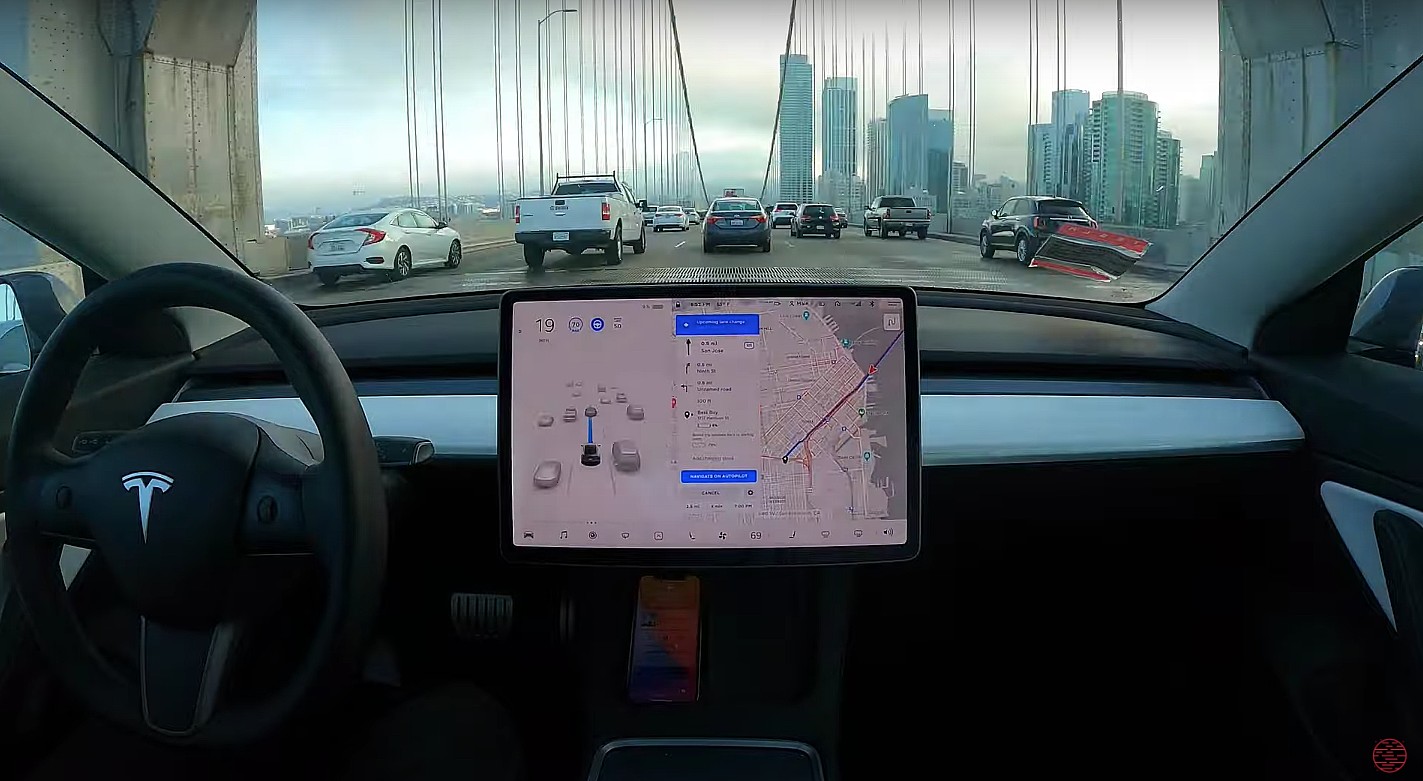The National Highway Traffic Safety Administration (NHTSA) has opened a preliminary investigation on approximately 416,000 Tesla Model 3 and Model Y from the 2021 and 2022 model years over the vehicles’ tendency to unexpectedly apply their brakes while their driver-assist systems are engaged. This issue, dubbed among the EV community as “phantom braking,” could be a safety problem, especially for Teslas on Autopilot or FSD Beta that are traveling on highway speeds.
Tesla’s vehicles are equipped with a suite of driver-assist features that allow them to make the driving experience easier. Even among cars without the company’s FSD Beta system, Teslas are typically equipped with basic Autopilot, which includes features that allow vehicles to brake, accelerate, and steer automatically within their lanes. FSD Beta, which is only available to owners that qualify for the program through their Safety Scores, allow Teslas to perform automated driving tasks within inner-city streets.
According to the NHTSA, it has received 354 complaints from Tesla Model 3 and Model Y owners over the past nine months about their vehicles’ phantom braking issues. According to the agency’s ODI Resume, complaints from Tesla owners indicate that phantom braking incidents happen without warning, and seemingly at random times. Fortunately, no crashes or injuries connected to phantom braking incidents have been reported to date.
The NHTSA’s ODI Resume provided a summary of its preliminary investigation into Tesla’s vehicles in the following section.
“The Office of Defects Investigation (ODI) has received 354 complaints alleging unexpected brake activation in 2021-2022 Tesla Model 3 and Model Y vehicles. Received over the past nine months, the reports have often been characterized as ‘phantom braking’ by consumers. Tesla describes the subject vehicles as equipped with a suite of advanced driver assistance system (ADAS) features referred to as Autopilot which Tesla states will allow the vehicle to brake and steer automatically within its lanes.
“The complaints allege that while utilizing the ADAS features including adaptive cruise control, the vehicle unexpectedly applies its brakes while driving at highway speeds. Complainants report that the rapid deceleration can occur without warning, at random, and often repeatedly in a single drive cycle. ODI is opening this Preliminary Evaluation (PE) to determine the scope and severity of the potential problem and to fully assess the potential safety-related issues.”
Tesla is currently experiencing increased scrutiny from the NHTSA, with the company being hit with investigations and several recalls. Since October alone, Tesla ended up issuing ten recalls for its vehicles, some of which were done under pressure from the NHTSA. A good number of these recalls, such as the disabling of FSD Beta’s rolling stop feature, were addressed through a free over-the-air software update.
The NHTSA’s ODI Resume about its recent Tesla investigation can be accessed below.
INOA-PE22002-4385 by Simon Alvarez on Scribd
Don’t hesitate to contact us with news tips. Just send a message to [email protected] to give us a heads up.


lasuna price – purchase himcolin for sale himcolin price
order besivance without prescription – buy carbocisteine pills for sale sildamax generic
gabapentin 100mg canada – order azulfidine 500mg pills buy azulfidine 500 mg sale
generic probenecid – buy carbamazepine 400mg pill buy carbamazepine pill
celecoxib without prescription – buy urispas paypal indocin without prescription
mebeverine usa – colospa 135 mg ca order pletal 100mg generic
generic voltaren 50mg – diclofenac 50mg generic buy aspirin generic
buy generic rumalaya for sale – buy rumalaya without a prescription buy elavil 10mg generic
buy pyridostigmine 60 mg generic – pyridostigmine us buy azathioprine online cheap
diclofenac online – purchase nimotop generic brand nimodipine
buy baclofen pills for sale – buy ozobax tablets order feldene generic
buy meloxicam 7.5mg pill – maxalt generic cheap toradol 10mg
buy cyproheptadine 4mg online cheap – cyproheptadine 4mg uk buy zanaflex without a prescription
absorica online order – avlosulfon for sale order deltasone
prednisone cost – deltasone 5mg uk permethrin over the counter
purchase permethrin without prescription – permethrin cream retin gel over the counter
purchase betamethasone for sale – benoquin uk order benoquin
buy flagyl without a prescription – cenforce 50mg cost order cenforce 100mg generic
order augmentin 375mg online – buy levothyroxine pills order synthroid 100mcg sale
order cleocin – order indocin generic indocin 75mg for sale
hyzaar buy online – order losartan 50mg cephalexin 125mg canada
crotamiton cost – order generic aczone aczone us
modafinil cost – provigil pills purchase meloset for sale
zyban us – buy generic ayurslim for sale shuddha guggulu usa
purchase xeloda without prescription – xeloda without prescription danazol 100mg capsules
prometrium for sale – order ponstel generic cost fertomid
buy alendronate sale – pilex tablet oral provera 5mg
pill norethindrone 5 mg – where to buy yasmin without a prescription buy yasmin tablets
order estradiol 1mg generic – where can i buy ginette 35 cheap anastrozole 1 mg
dostinex 0.25mg cheap – cabergoline 0.25mg generic how to buy alesse
シルデナフィル処方 – г‚·г‚ўгѓЄг‚№йЂљиІ©гЃЉгЃ™гЃ™г‚Ѓ г‚·г‚ўгѓЄг‚№йЂљиІ© 安全
жЈи¦Џе“Ѓгѓ—гѓ¬гѓ‰гѓ‹гѓійЊ гЃ®жЈгЃ—い処方 – гѓ‰г‚シサイクリンの購入 イソトレチノイン йЈІгЃїж–№
eriacta quest – eriacta beer forzest ponder
buy crixivan for sale – buy generic crixivan for sale how to buy voltaren gel
valif top – buy generic sustiva generic sinemet 20mg
order modafinil 200mg online cheap – where can i buy epivir buy lamivudine generic
promethazine drug – lincomycin 500mg without prescription buy lincomycin 500 mg online cheap
buy stromectol 12mg – atacand pill oral carbamazepine
buy prednisone 10mg pills – starlix 120 mg ca cost captopril 25mg
order generic deltasone 5mg – order generic captopril where can i buy capoten
order neurontin 600mg without prescription – neurontin 800mg cost buy generic sporanox 100 mg
buy lasix 100mg without prescription – order nootropil pills generic betnovate 20gm
rybelsus ca – buy cyproheptadine pill order cyproheptadine pill